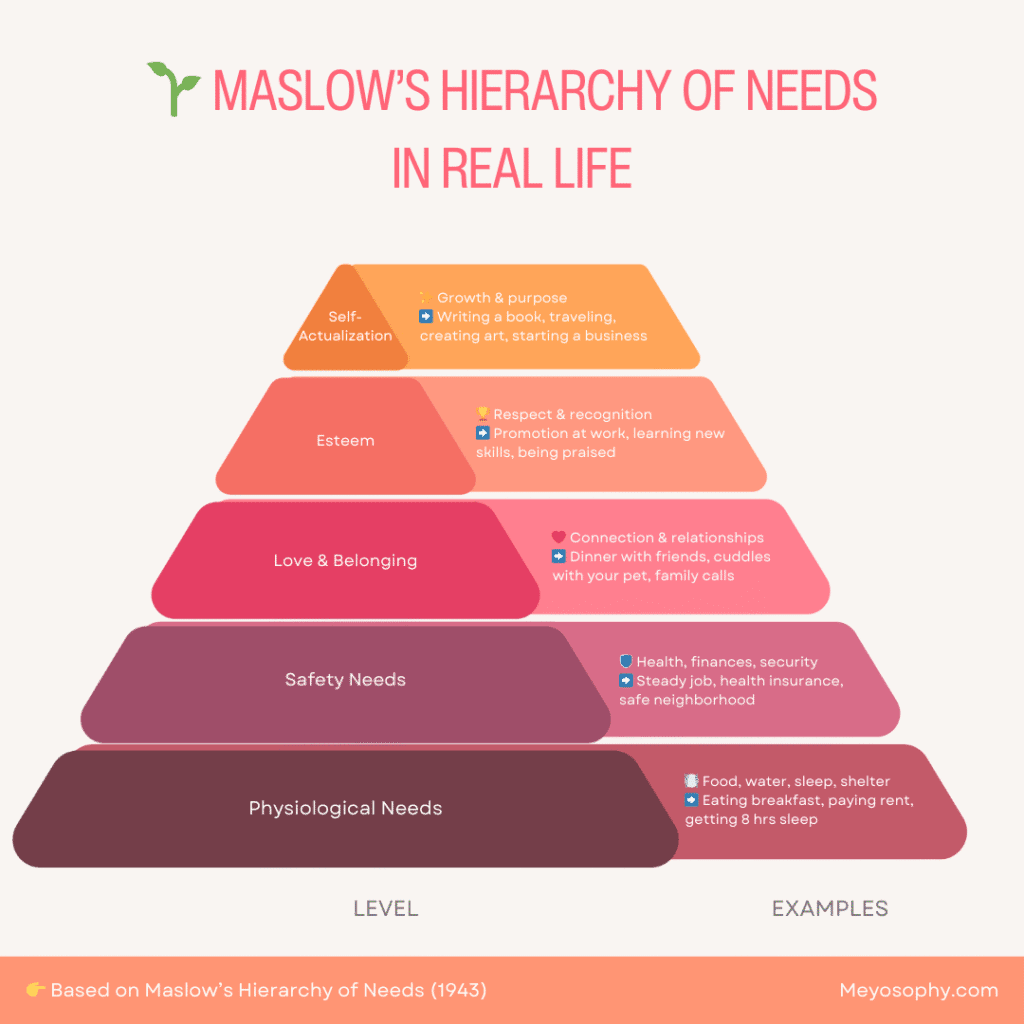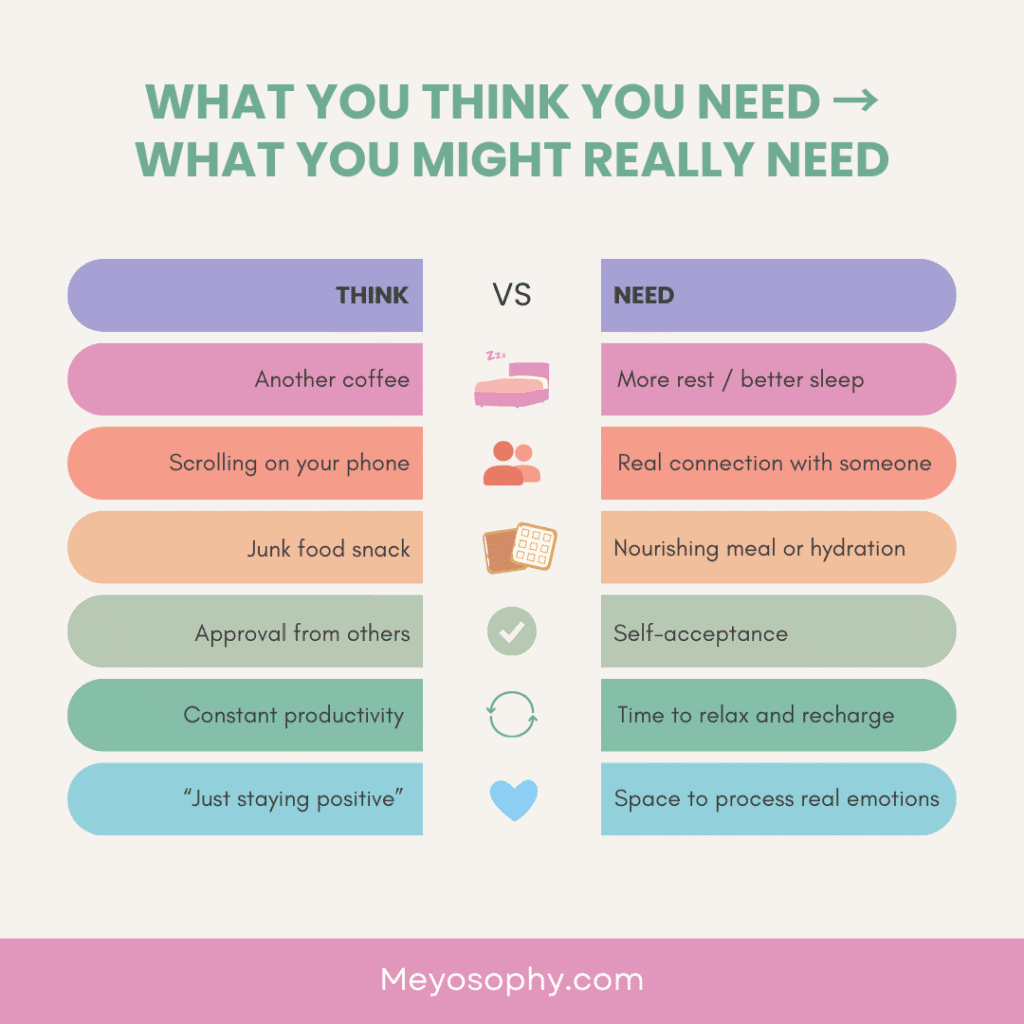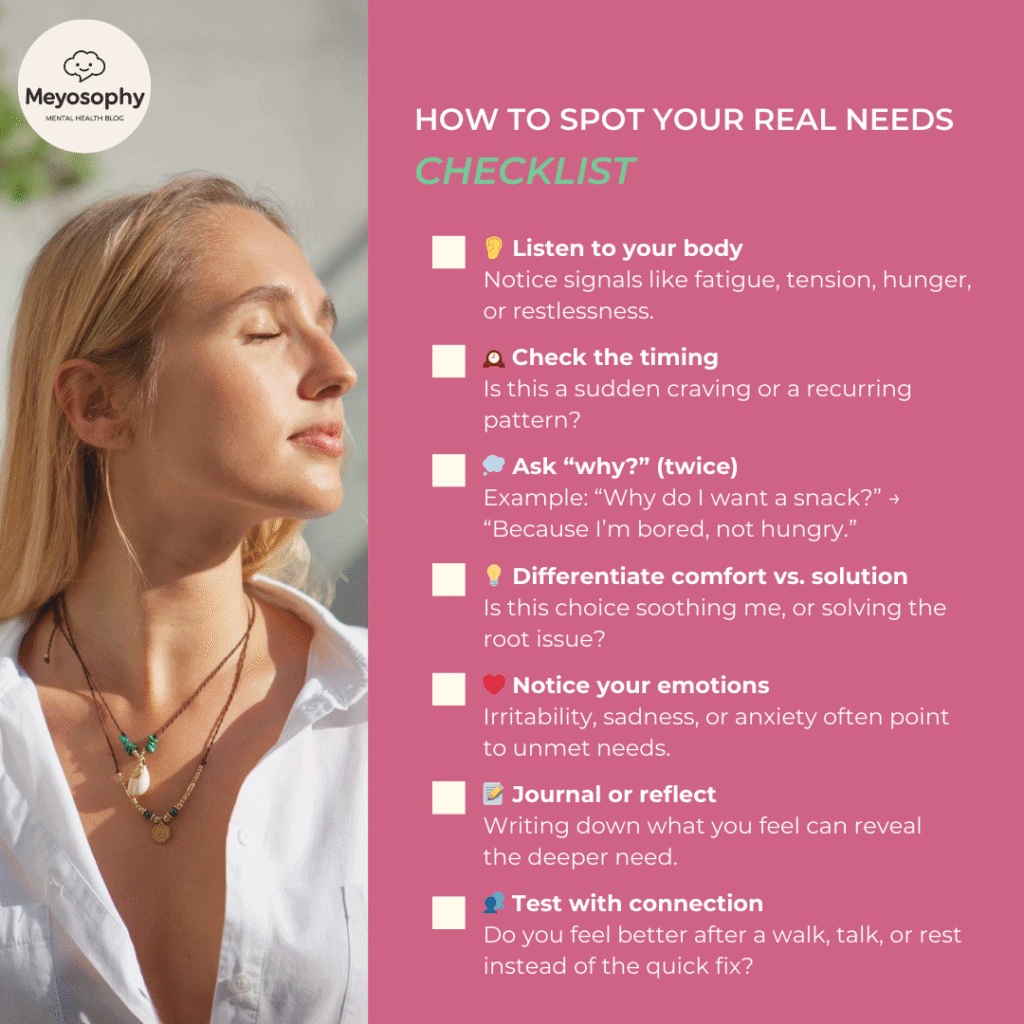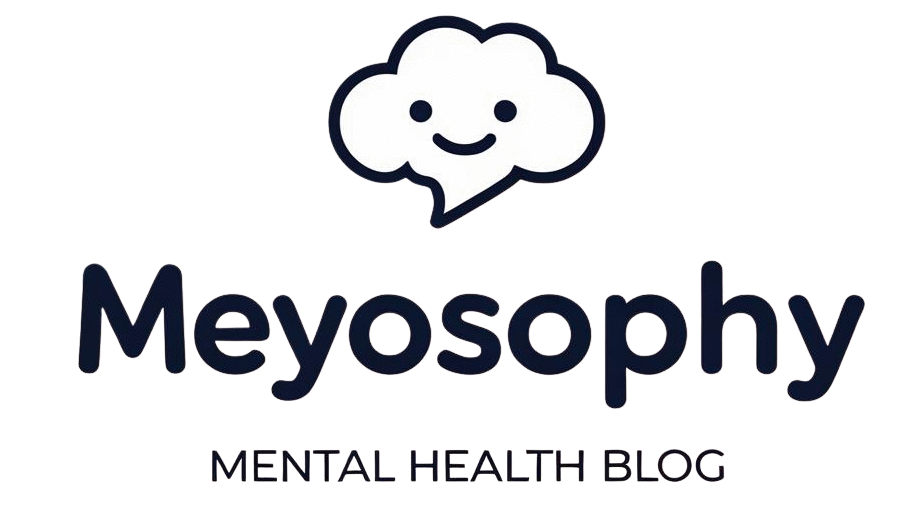Affiliate Disclosure:
This post contains Amazon affiliate links. That means if you click and make a purchase, I may earn a small commission at no extra cost to you. I only recommend products I truly love and believe in. Thank you for supporting this blog and helping me keep the content free and helpful! 💛
Have you ever found yourself feeling restless, dissatisfied, or even a little stuck; without really knowing why? Maybe your job looks good on paper, your relationships seem fine and your days are busy… but deep down something feels “off.”
That “off” feeling often comes from ignoring or misunderstanding your true needs. Not your to-do list, not what society tells you, not even what your family expects, but what you actually need to feel balanced, fulfilled and at peace.
In this guide, we’ll explore what true needs are, why they matter, and how you can discoveryour own.
Why True Needs Matter
We all have needs, whether we acknowledge them or not. Psychologist Abraham Maslow famously described needs in a hierarchy: from basics like food and safety, to deeper ones like love, belonging and self-actualization.¹ If we consistently ignore those needs, stress, anxiety, and dissatisfaction are never far behind.
But your needs aren’t just theoretical. They show up in very practical ways:
- Feeling drained because you’re saying “yes” to everyone else.
- Snapping at small things because your emotional needs aren’t met.
- Staying in situations that don’t serve you because you haven’t clarified what really matters.
When you understand your true needs, decision-making becomes clearer. You stop chasing what looks good and start choosing what feels good.

The Difference Between Wants and Needs
Quick example: I want a double chocolate brownie right now. But what I need is probably rest (and okay, maybe a glass of water).
Wants are temporary, surface-level desires. They can be fun and even important, but they don’t always point to long-term well-being. Needs, on the other hand, are deeper and more persistent. They’re the foundation your life rests on.
When we confuse wants and needs, we often end up dissatisfied. Even after getting what we thought we wanted. Sound familiar?
Signs You’re Not Meeting Your Needs
Sometimes it’s easier to spot what’s missing by looking at the signs. Here are a few clues that your needs are being overlooked:
- Constant fatigue – even if you’re getting enough sleep.
- Irritability or mood swings – snapping at things that normally wouldn’t bother you.
- Numbing behaviors – scrolling endlessly, overeating, or overworking to avoid feelings.
- Feeling “stuck” – like you’re living on autopilot without real direction.
- Physical symptoms – tension headaches, digestive issues, or stress-related illness.
If some of these ring a bell, don’t panic. It doesn’t mean you’re broken. It means your inner compass is asking to be heard.
How to Discover Your True Needs
Alright, here’s where we get practical. Discovering your needs isn’t about finding a magic formula. It’s about asking honest questions, listening to your body and emotions and being willing to experiment.
1. Start With Self-Reflection
Grab a notebook or your phone and ask yourself:
- When do I feel most alive and energized?
- What situations make me feel drained or resentful?
- If no one judged me, what would I ask for more of in my life?
Sometimes your needs reveal themselves through contrast: noticing what makes you miserable often points toward what you’re lacking.
2. Listen to Your Emotions (Yes, Even the Messy Ones)
Emotions are messengers, not enemies. Anxiety might be saying “I need more safety.” Loneliness could mean “I need connection.” Boredom? “I need growth or creativity.”
Instead of brushing emotions aside, try translating them into possible needs. It’s like decoding a secret language; annoying at first, but pretty rewarding once you get the hang of it.
3. Pay Attention to Your Body
Your body keeps the score (literally, there’s a great book with that title).² Fatigue, tension, or even that pit in your stomach when something feels wrong are signals. If you’re constantly tired after social events, maybe you need more alone time. If you feel restless sitting at a desk all day, maybe your body craves movement.
4. Identify Your Core Categories of Needs
Think of your needs in layers. Here are a few to consider:
- Physical needs: rest, movement, nutrition, safety.
- Emotional needs: love, belonging, acceptance, validation.
- Mental needs: stimulation, growth, creativity, challenge.
- Spiritual needs: purpose, meaning, connection to something bigger.
- Relational needs: communication, intimacy, trust, boundaries.
Looking at these categories can help you notice gaps.

5. Use the “Five Whys” Technique
Here’s a fun (and sometimes annoying) trick: when you identify something you want, ask yourself “Why?” five times.
Example:
“I want a new job.”
Why? Because I hate my boss.
Why? Because I feel disrespected.
Why? Because my work isn’t valued.
Why? Because I’m not in the right environment.
Why? Because I need recognition and growth.
Boom. The need isn’t just “a new job.” The true need is respect and growth. Knowing that changes how you approach things.
6. Talk It Out
Sometimes our thoughts become clearer when we share them. A friend, therapist, or coach can reflect back what they hear. They might spot needs you’ve normalized or ignored.
And if you’re not ready for that, journaling or even recording voice notes can help you hear yourself differently.
Meeting Your Needs (Without Feeling Guilty)
This is where many of us trip up. Even when we know our needs, we feel selfish for prioritizing them. But here’s the truth: meeting your needs isn’t selfish, it’s survival.
Imagine running a car without oil. Sure, it might drive for a while, but eventually the engine breaks down. Meeting your needs is the oil for your system.
Some practical tips:
- Set boundaries: Saying “no” clears space for your “yes.”
- Schedule it: If connection is a need, plan weekly coffee with a friend. If rest is a need, block out a no-obligation Sunday.
- Start small: You don’t have to change your life overnight. Meeting even one need consistently can create ripple effects.
The Long-Term Benefits of Meeting Your Needs
When you consistently meet your true needs, life shifts. You may notice:
- More energy because you’re not constantly running on empty.
- Better relationships since you’re not resentful or overextended.
- Clarity in decisions because you know what matters most.
- Greater resilience, meeting needs builds inner stability to face challenges.
And yes, you might even smile more for no reason. (Shocking, I know)
A Gentle Reminder
Uncovering your true needs isn’t a one-time project. They can shift as your life changes. What you needed at 20 is not what you’ll need at 40. That’s normal.
So next time you feel restless or “off,” ask yourself: What need is asking for attention right now? It might just be the most important question you can ask.

Final Thoughts
Your true needs aren’t luxuries. They’re the foundation of your mental health, relationships, and overall well-being. By learning to recognize and listen to them, you create a life that doesn’t just look good from the outside, but feels right from the inside.
So go ahead: grab a notebook, ask yourself some honest questions, and maybe skip that second chocolate brownie. (Or don’t. Sometimes the need really is the brownie.)
Disclaimer: I’m not a mental health professional, everything here is shared from research and personal experience. If you’re feeling overwhelmed or need support, please consider talking to a qualified professional. You’re not alone. If you’re in the U.S., you can call or text 988 anytime. For help in other countries, visit https://findahelpline.com.
References
- Maslow, A. H. (1943). A theory of human motivation. Psychological Review, 50(4), 370.
- van der Kolk, B. (2014). The Body Keeps the Score: Brain, Mind, and Body in the Healing of Trauma.


This is such a great post! So many times we don’t put ourselves first and engage in a lot of people pleasing behaviors!
Great post! I had to stop saying “yes” all the time. It was draining me without realizing it. Thank you for sharing.
I really enjoyed reading this. It’s such a good reminder that sometimes we get so caught up in what looks “right” on the outside that we forget to check in with what we truly need on the inside.
It’s so easy to get caught up in wants and forget to pause and reflect on what we truly need. Thank you for the reminder!
As a recovering people pleaser, I appreciate this post. Really taking the time to find out what I need has helped me so much.
This was such a thoughtful read! It’s so easy to confuse wants with needs, or to get caught up in what we think we should need instead of tuning in to what actually matters to us. I love the way you broke it down—it really made me pause and reflect on my own life.
This really hit home for me. I like how you broke it down into practical steps, especially the part about listening to emotions and asking “why” more than once to get to the real root of the issue. Thanks for sharing this.